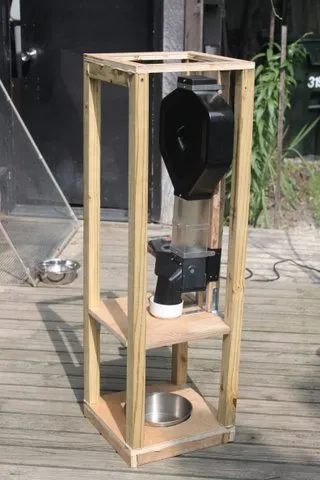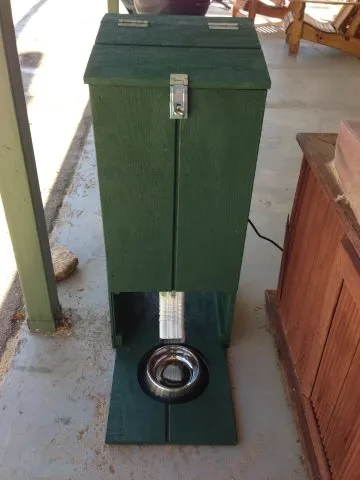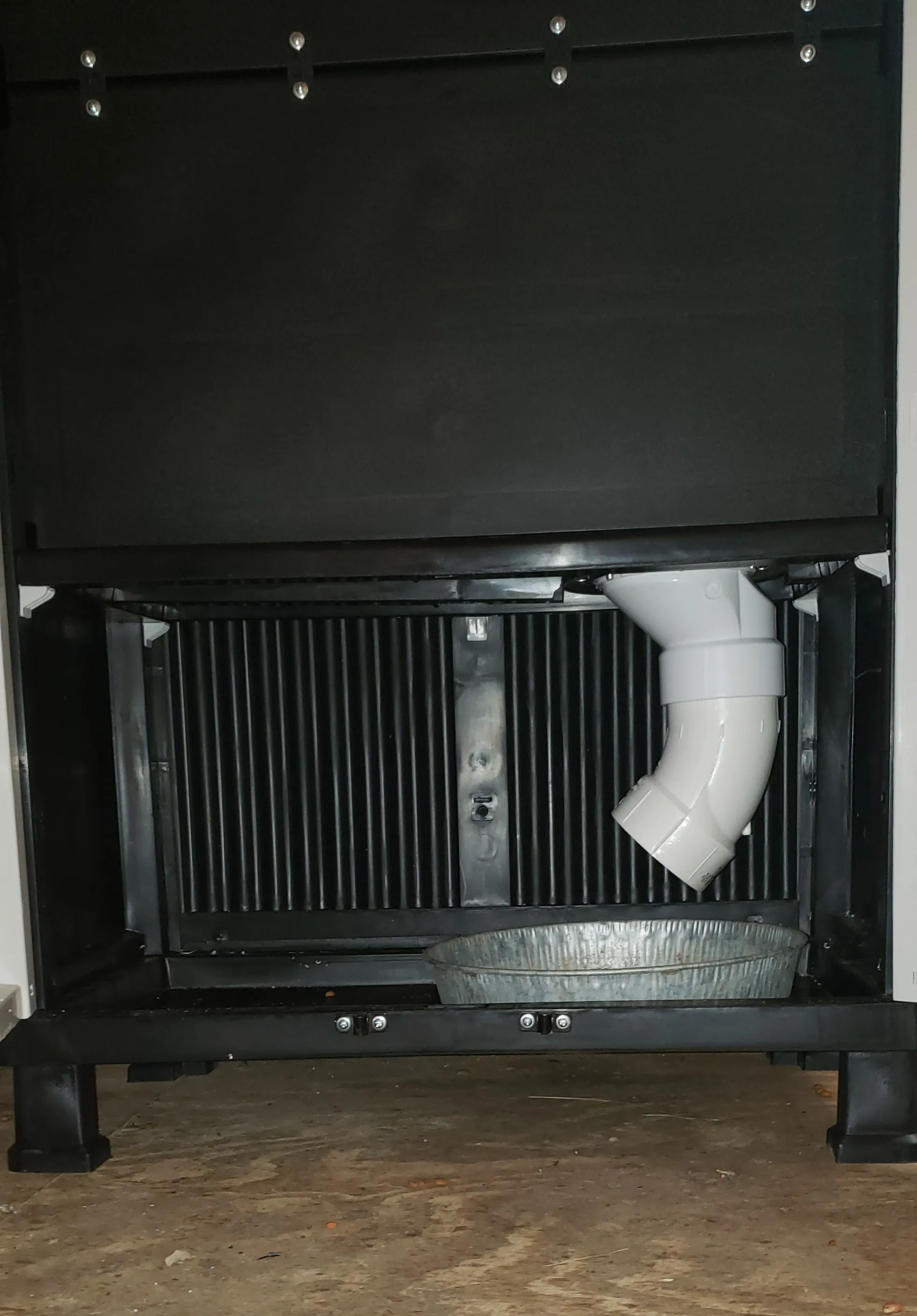For pet owners, especially those with larger breeds or multiple dogs, ensuring consistent and convenient feeding is paramount. An Extra Large Automatic Dog Feeder offers a sophisticated solution to manage your dog’s meals efficiently. This guide delves into the features, benefits, and considerations for choosing the right automatic feeder to cater to the needs of your beloved canine companions.
An extra large automatic dog feeder is designed to dispense pre-portioned meals at scheduled times, eliminating the daily hassle of manual feeding. This technology is particularly beneficial for busy pet parents, those who travel frequently, or households with dogs requiring strict dietary management. The “extra large” aspect signifies a significant food capacity, capable of holding enough kibble for several days, making it ideal for larger dogs who consume more food per meal or for situations where you might be away for an extended period.
 An extra large automatic dog feeder set up outdoors with a large dog enjoying its meal.
An extra large automatic dog feeder set up outdoors with a large dog enjoying its meal.
Understanding the Benefits of an Extra Large Automatic Dog Feeder
The advantages of investing in an extra large automatic dog feeder extend beyond mere convenience. They play a crucial role in your dog’s health and your peace of mind.
Consistency in Feeding Schedule
Dogs thrive on routine. An automatic feeder ensures that your dog receives meals at precisely the same times each day, which can aid in digestion, reduce anxiety, and prevent behavioral issues stemming from inconsistent feeding. This consistency is especially important for puppies, senior dogs, or those with medical conditions requiring a regular food intake.
Portion Control and Weight Management
Overfeeding is a common problem that leads to canine obesity and associated health risks like joint problems, diabetes, and heart disease. An extra large automatic dog feeder allows you to program precise portion sizes for each meal. This feature is invaluable for maintaining a healthy weight for your dog, especially for breeds prone to weight gain or for dogs on a veterinarian-prescribed weight loss plan.
Convenience for Busy Pet Owners
Modern life is often hectic. Whether you’re working late, stuck in traffic, or planning a short trip, an automatic feeder guarantees your dog will be fed on time. This eliminates the stress of rushing home to feed your pet and ensures they don’t go hungry, which can lead to destructive behavior or digestive upset.
Ideal for Multiple Dog Households
Managing feeding for multiple dogs can be challenging, especially if they have different dietary needs or feeding schedules. An extra large automatic dog feeder can be programmed to dispense different portion sizes, catering to the individual requirements of each dog, thereby preventing food aggression or ensuring everyone gets their fair share.
Key Features to Consider in an Extra Large Automatic Dog Feeder
When selecting an extra large automatic dog feeder, several features are critical to ensure it meets your needs and those of your dog.
Capacity
The “extra large” designation implies a significant food capacity. Look for feeders that can hold at least 10-15 pounds of kibble, with options for expansion. The original CSF-3XL, for instance, can be configured with multiple hoppers to reach capacities of up to 44 cups or even 48 cups (approximately 10 lbs), making it suitable for larger breeds or longer periods between refills.
Programmability and Flexibility
The ability to schedule multiple meals per day is a standard, but look for feeders that offer flexibility. The capacity to set different feeding times and portion sizes for each meal is essential. The ACDT-35 digital timer included with some models allows for up to 20 feedings daily, offering remarkable control.
Durability and Build Quality
Given that these feeders will be dispensing food regularly, often outdoors, durability is key. Stainless steel or robust BPA-free plastic construction is preferable. For outdoor use, weatherproofing and protection against pests like raccoons are crucial considerations. The feeder’s chute opening should be protected, and the unit itself should be housed securely.
 A close-up of an extra large automatic dog feeder showing its robust construction.
A close-up of an extra large automatic dog feeder showing its robust construction.
Ease of Cleaning and Maintenance
A feeder that is difficult to clean can become a breeding ground for bacteria, posing health risks to your dog. Opt for models with removable parts that are dishwasher safe or easy to wipe down. The ability to easily access and clean the hopper and dispensing mechanism is important for hygiene.
Power Source and Reliability
Most automatic feeders operate on AC power, requiring a connection to a wall outlet. Some models offer battery backup to ensure feeding continues even during a power outage. For outdoor installations, ensuring a reliable and safe power supply is paramount. The provided outdoor power supply kits with sealed connectors are designed for this purpose.
Kibble Compatibility
Not all automatic feeders are compatible with all types of kibble. Smaller, round kibbles generally dispense more accurately than larger, irregularly shaped ones. Most feeders work well with kibble sizes up to 5/8″ in diameter, but accuracy may slightly decrease with non-standard shapes. It’s advisable to check the manufacturer’s recommendations for kibble size and shape.
Installation and Usage Tips for Your Extra Large Automatic Dog Feeder
Proper installation and usage are vital to maximize the benefits and lifespan of your extra large automatic dog feeder.
Outdoor Installation Considerations
When mounting a feeder outdoors, protection from the elements and wildlife is paramount.
- Pest Protection: Raccoons and other animals can be persistent. Consider mounting the feeder inside a sturdy enclosure, a modified trash can, or a dog house to prevent access. Ensure the chute opening is protected with a cover, but be aware that even these covers might not deter determined animals.
- Weatherproofing: Protect the feeder and its power supply from rain, snow, and extreme temperatures. Using outdoor-rated power cords and sealed connectors is essential.
- Placement: Position the feeder in a location that is easily accessible for you to refill but out of reach of potential pests and away from areas that might become waterlogged.
Indoor Installation and Use
For indoor use, an extra large automatic dog feeder can still offer significant advantages.
- Space-Saving Designs: Some feeders come with integrated stands and bowls, making them a neat addition to your kitchen or feeding area.
- Ease of Monitoring: Indoors, it’s easier to monitor your dog’s eating habits and the feeder’s performance.
- Optional Accessories: For indoor use, you might consider a combo that includes a plastic stand and bowl, and a timer for added convenience.
Power and Timer Setup
- Power Adapters: Always use the correct power adapter as specified by the manufacturer. Never connect two power adapters simultaneously to avoid damaging the feeder or voiding the warranty.
- Digital Timer Programming: Follow the timer manufacturer’s instructions carefully to set the desired feeding schedule. Ensure the timer can reliably turn the feeder on and off for the programmed feed cycles.
- Home Automation Integration: For tech-savvy owners, some feeders can be integrated with home automation systems. This typically involves plugging the feeder’s power adapter into a smart outlet that your system can control, allowing you to trigger meals remotely or via voice commands. It’s crucial that the smart outlet completely cuts power during its “off” cycle to allow the feeder to reset correctly.
Maintaining Your Extra Large Automatic Dog Feeder for Longevity
Regular maintenance ensures your extra large automatic dog feeder functions optimally and hygienically.
- Daily Checks: Briefly inspect the feeder daily to ensure it is dispensing food correctly and that there are no obstructions.
- Weekly Cleaning: Disassemble and clean the food hopper, dispensing mechanism, and bowl (if applicable) weekly using mild soap and water. Ensure all parts are thoroughly dried before reassembly to prevent mold and mildew.
- Monthly Deep Clean: A more thorough cleaning can be done monthly, paying attention to any hard-to-reach areas.
- Regular Software/Firmware Updates: If your feeder has smart features, check for and install any available updates to ensure optimal performance and security.
- Inspect Power Cords: Regularly check power cords for any signs of damage or wear and tear, especially if used outdoors. Replace them immediately if compromised.
 A person cleaning the parts of an extra large automatic dog feeder.
A person cleaning the parts of an extra large automatic dog feeder.
Choosing the Right Extra Large Automatic Dog Feeder for Your Needs
The selection of an extra large automatic dog feeder should be based on a thorough assessment of your dog’s size, appetite, dietary requirements, and your lifestyle. Features like high capacity, precise portion control, durable construction, and reliable programming are essential. By understanding these aspects and following best practices for installation and maintenance, you can ensure your canine companion receives consistent, healthy meals, contributing to their overall well-being and happiness.
For owners seeking a robust, versatile, and long-lasting solution for feeding larger dogs, an extra large automatic dog feeder like the CSF-3XL offers a compelling combination of capacity, programmability, and durability, backed by years of proven performance and readily available parts for future servicing.
